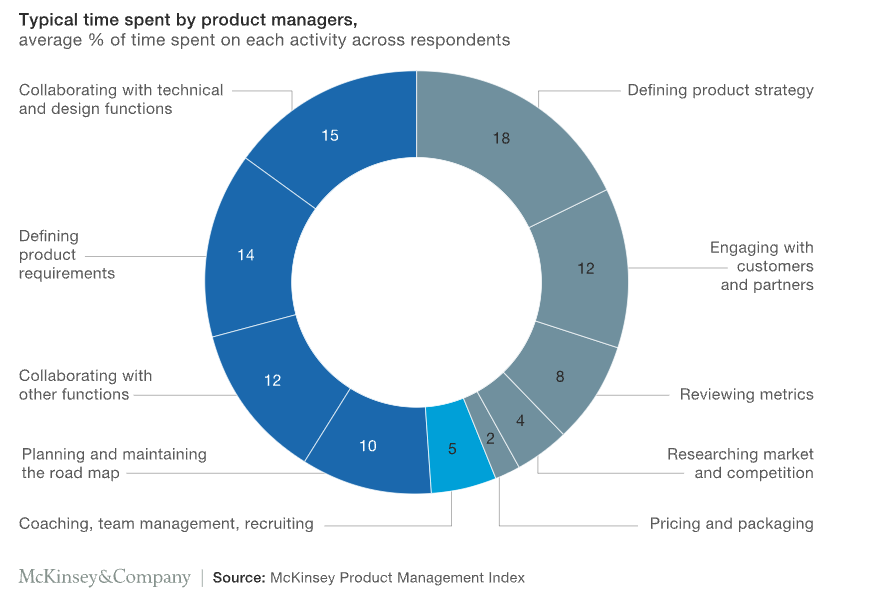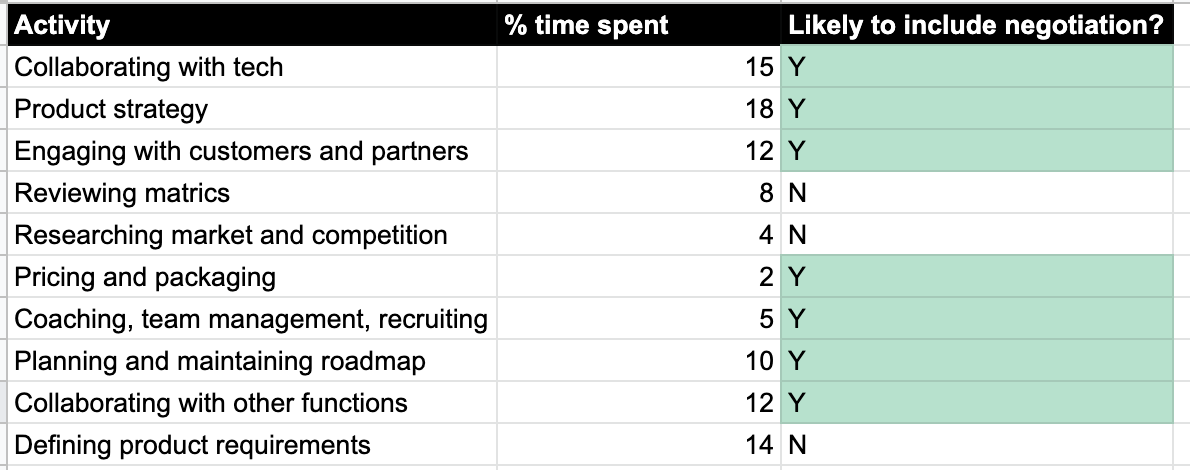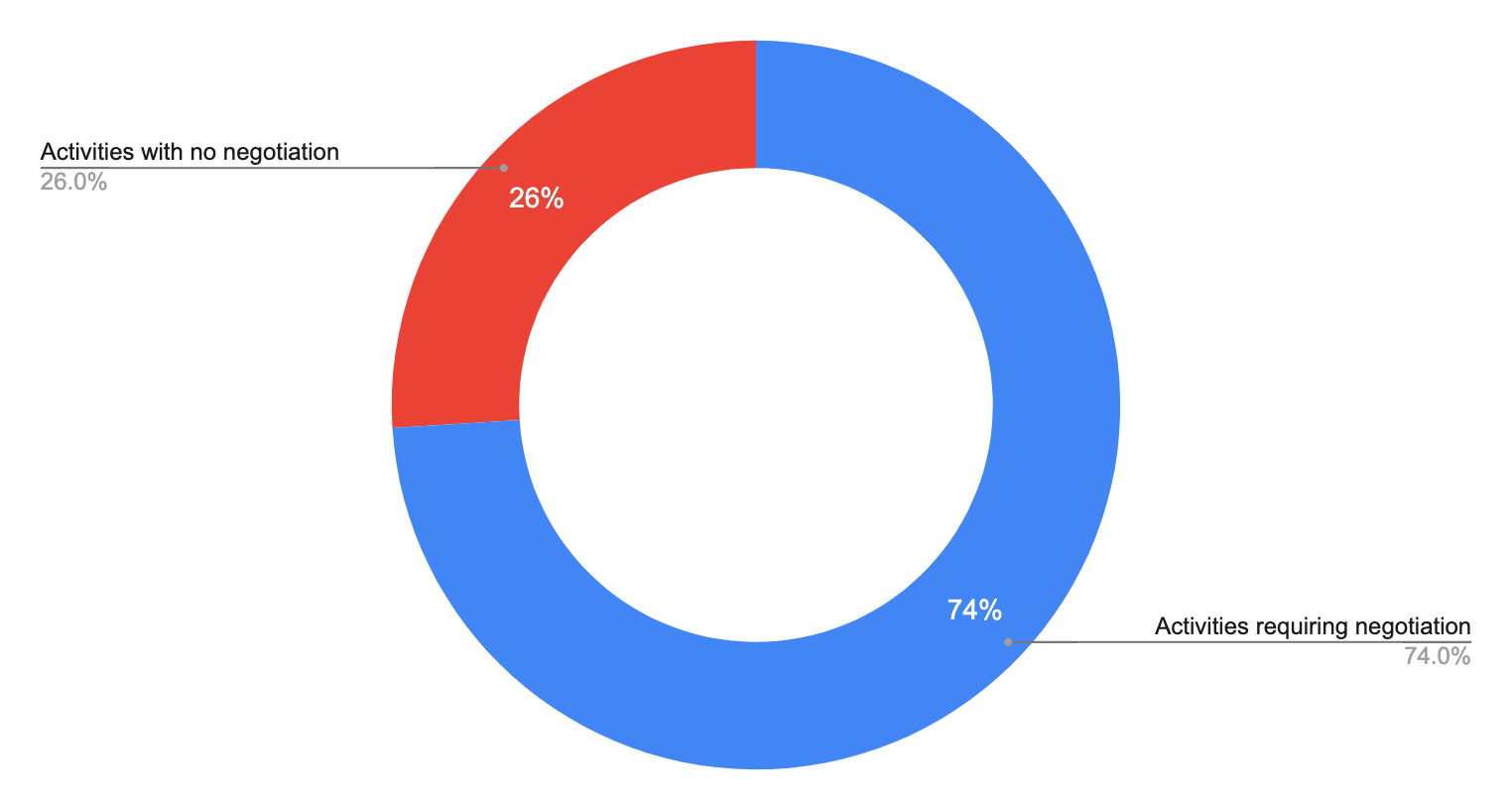Negotiation Skills for Product Managers
How to thrive in a constant state of negotiation
A typical week in a product manager’s life could include a mix of negotiations with any – or all – of the following:
- Stakeholders – where’s that feature you said you’d deliver?
- Engineers – why do we want to build this? The way you’ve asked for it to be built is too difficult. How about we change the scope a little? And what about the tech debt that we need to tackle?
- Third parties – are your API docs up to date? We’ll be charging you on a cost per API call basis. Is that OK?
A recent study by McKinsey showed that the average % time spent across each of the following activities looks like this:

If we were to bundle up all of the activities that are likely to involve some form of negotiation, we’d end up with something like this:

Summary of time spent in activities involving negotiation (estimated)

Clearly, then, negotiation is a fundamental part of a product manager’s life. So it’s probably worth spending a bit of time understanding the different types of negotiation and how you can excel as a negotiator in day to day product management.
Positional negotiation vs. principled negotiation
The traditional approach to negotiation can be described as ‘positional negotiation’. This means, 2 negotiating parties take 2, often opposing, positions and the goal of the negotiation is to meet in the middle somewhere.
| Position A | Position B |
|---|---|
| How much for the hat?I’ll give you $15 | $75 for the hat please |
In this simple example, the negotiation starts with 2 opposing positions and the goal of the negotiation would be to reach an agreement on the price of the hat.
In a positional bargaining approach, it’s often the ‘hardest’ who win; those who dig into their position, refuse to budge and apply pressure will beat those who yield to pressure, change position easily or accept one-sided losses to reach an agreement.
This is bad news for soft negotiators but thankfully there is an alternative way to negotiate using something called principled negotiation instead.
The 4 facets of principled negotiation
This methodology was created by a group known as the Harvard Negotiation Project whose primary focus was to gain a deeper understanding into the nature of negotiation practices.
According to the study, there are 4 facets which make up principled negotiation:
- People
- Interests
- Options
- Criteria
When tackling a negotiation, it’s likely that you’ll lean on each of these 4 different facets in order to achieve a result which solves the problem you’re tackling.
Let’s explore each of these different facets and – crucially – understand how they impact you and your day to day role in product management.
First up, people.
1. People
Often when you’re negotiating, people and problems become entangled. People often become attached to their own problems and sometimes see the problem they’re tackling as an extension of their own personality.
A reporting tool bug isn’t just a reporting tool bug, it’s John’s reporting tool bug. A request to build a CRM isn’t just a request to build a CRM, it’s ‘Natalie’s request to build a CRM’.
Entangling people with problems happens all the time in product development, and the first step to a successful principled negotiation is to separate the two.
How to separate people from problems in product development
- Names – don’t refer to products or feature requests by the name of the requestor. Not only will this create all kinds of problems when you’re trying to negotiate with stakeholders, it’s not a smart way to approach building products since you’re meant to be building products for more than one person 🙂
- Focus on the problem – instead of fixating on the people involved in the negotiation, instead focus on the problem. This is easier said than done, but solid product people will often have the ability to switch focus away from parties involved and instead fixate on the problem everyone is collectively trying to solve.
- Empathy – the ability to see things from multiple perspectives is a skill that will serve you well in product management generally, but specifically in negotiations.
- Participation – ask stakeholders or negotiation partners to participate in the problem solving process. Ask for advice, get inputs on perspectives early and openly give credit for ideas that they have generated.
- Emotion – resist the temptation to react emotionally to specific situations. This will often be difficult, but if you do work with volatile characters, step away from any negotiation situations until emotions have settled and both participants are willing to engage in constructive conversations instead.
The tricky part here though, is that as much as you’d love to completely disentangle people from problems, wherever there are people involved, there are also specific interests at play.
2. Interests
Understanding the fundamental interests at play in a negotiation is critical. When we’re negotiating we all have different interests; if we didn’t, we’d just agree to everything all the time and negotiations wouldn’t exist.
In product management, understanding different perspectives and different interests is essential for achieving a successful outcome in a negotiation. And a successful outcome doesn’t mean an outcome you want; it may be that after the process of negotiation, you actually realise that your starting position wasn’t correct and that you might need to change direction to best tackle a problem or achieve a goal.
Shared vs. divergent interests
In a negotiation context, there will always be shared and divergent interests. Shared interests are common to both parties, divergent interests are where the two parties disagree.
Let’s take a look at a simple, non-product example first.
Example – landlord and tenant
| Shared interests | Divergent interests |
|---|---|
|
|
The most powerful human interests
When you’re negotiating with another party and you’re trying to identify their interests, it’s likely to be a manifestation of one of the most powerful human interests.
What are they?
- Security – protection against outside threats
- Wellbeing – feeling good about oneself
- Sense of belonging – belonging to a wider group of people or interests
- Recognition – to be recognised alongside your peers and be seen as important
- Control – to be in control of your own affairs
How the most powerful human interests manifest themselves in a product context
Once you’re aware that these are typically the most common interests that humans have, you’ll be able to better navigate complex negotiations with stakeholders and other third parties – because you’ll be able to identify instances of each of these interests whenever they arise.
Let’s take a look at some examples of how some of these might arise in a product context.
| Human need | How it manifests itself | How to address the need |
|---|---|---|
| Security | “We’ll lose revenue with this new checkout flow” | Risk management and testing up front – involving all key stakeholders. |
| Recognition | “If other departments are having items built by the product team, why can’t I?” | Focus less on the departments and more about the problems they solve and the goals they achieve. |
| Control | “The product team just decide what to do without telling us” | Involve stakeholders from the outset. Listen to people, take inputs. |
If you’re struggling to identify what the interests of the other person might be, ask why they believe in or want something. And ask them why they disagree with your perspective as well. This will often uncover the true nature of the interests at play.
And the role of a PM during this negotiation process is to help the other side feel as though you understand their interests and would like to come to a mutually beneficial understanding. Simply reiterating the other person’s interests back to them goes a long way in building this rapport.
3. Options
The third step in a successful principle-based negotiation – and for PMs generally when negotiating – is to generate some options. If you’re stuck at an impasse with no obvious route out of a problem, generating options – no matter how absurd they seem – can help you to get moving again.
How to effectively generate options as part of a negotiation
- Separate inventing from deciding – before deciding which option to go for, invent the options first – don’t muddle the two. So many people struggle with this. You’ll suggest an option and be hit with a barrage of reasons why it’s a terrible idea. But it’s firstly important to just create the option, and not decide on building it.
- Look through eyes of multiple perspectives – options shouldn’t just be created purely from a product manager’s perspective; instead, consider how the option might be perceived by the person involved in the decision.
- Make decision making easy – present options in a clear format so that your audience can easily compare and contrast between them. I’ve found that drawing inspiration from price comparison tables used by SaaS products can be a helpful way to present options to stakeholders. Using checks and crosses helps to visualise at a snapshot, the pros and cons of a particular option.
In a product context, generating options help you to move out of stalemate and towards a solution. If you’re totally stuck, even just the action of writing down the option ‘do nothing’ can help you to get started – and move towards a solution.
4. Objective criteria
When humans are involved in negotiating with each other, it’s almost inevitable that psychology and human emotion influence the direction of the negotiation. One way to combat this, is to ensure that your negotiation defers to using objective criteria wherever possible.
For example, let’s say you’re negotiating with a vendor who is providing you with a third party API used to power a specific part of your product. They say they’ll charge you X amount per API call but you don’t think it’s a fair amount.
Using objective criteria, you can assess whether or not the offer is fair. In this case, your objective criteria might be:
- How much they previously charged
- Their price compared to competitors in the market
- How much other teams in your org are paying to use similar services provided by the company
In another example, let’s say stakeholders are adamant that you desperately need a mobile app. The objective criteria to use in this context would be the latest data from your analytics tools which shows that only a tiny fraction of your users are visiting your website or using your product on a mobile device.
One of the most effective ways to use objective criteria is to agree the criteria upfront with the other negotiating party. That way, once you use it in your negotiations, you’ll both have agreed that the criteria is a valuable way to influence the direction of the negotiation.
Types of objective criteria to use in negotiations
- Fair market value
- Professional standards
- Scientific judgement
- Raw data
Each of these are examples of the types of criteria you can use to aid your negotiation – especially when you’re stuck and need guidance from data.
Bringing it together – an end to end example
OK, so we’ve touched upon a couple of examples throughout but let’s now explore an end to end example which brings together all of the concepts we’ve mentioned so that the next time you find yourself in a negotiation, you’re well equipped to deal with it and achieve a successful outcome.
Example – ‘We need a CRM’
Let’s imagine you’re a PM at a new startup and the head of marketing says you desperately need a CRM. It’s early days and implementing a CRM would take up engineering resource away from building other things which could prove product market fit.
Here’s some ideas on how you could approach this situation using principled negotiation tactics.
People
First up, separate the problem from the people. This isn’t X person’s request to build a CRM, it’s likely to be a symptom of a separate problem that you need to explore further.
Interests
What human interests are at play?
- Security – maybe the sales and marketing team are not confident that they can handle the potential influx of upcoming traffic that’s planned and need some reassurances.
- Wellbeing – perhaps a customer has complained about the level of responsiveness in the customer service team which has led to calls for a CRM to be introduced
- Sense of belonging – did other parts of the business get allocated product / engineering time in the latest iteration of the roadmap? What has this done to morale in other parts of the company?
- Recognition – were sales and marketing excluded from the prior quarterly roadmap discussions? What has this done to the relationship between product and marketing?
- Control – a CRM gives far greater control to the sales / marketing team, making them less dependent on other folks in the business. A desire for control could be a contributing factor
These are just made up examples, of course. A PM’s role is to have meaningful conversations to uncover some of the true reasoning behind feature requests like this. And it’s important to identify shared and divergent interests, too.
What shared and divergent interests do you both have?
Shared interests in this context include a mutual desire to grow the company and achieve sales and marketing metrics.
Divergent interests in this example would be the PMs desire to focus product / engineering effort on other prioritised roadmap items vs. the sales / marketing’s interest to invest heavily in integrating with a third party CRM.
Options
Once interests are identified, there may be options you can co-create which help guide the negotiation. In this example, options could include:
- Focus heavily on the CRM and de-prioritise other roadmap items
- Improve the existing solution with light weight improvements that solve specific problems but don’t take up all of the engineering effort you may have originally estimated
- Use alternative tools to tackle the customer service issues and responsiveness as a temporary stopgap
Criteria
Finally, you’re working through a negotiation like this, data can work in everyone’s favour.
If the request is to integrate with and choose a CRM, objective criteria can be used to influence the negotiation.
In this example, data points could include:
- NPS – are customers genuinely less happy at the moment? Is this due to lack of responsiveness?
- Responsiveness rate – are we tracking our responsiveness rate? What is it and what should it be?
- Closed deal ratio – are we closing less deals because of inefficiencies in our sales funnel?
Working in product management can sometimes feel like you’re in a constant state of negotiation. And to some extent, that’s true. So with so much of our time spent negotiation, it’s probably worth equipping yourself with some tools on how to succeed in negotiation – even if that doesn’t always mean getting what you want.



